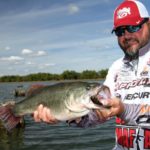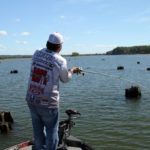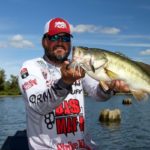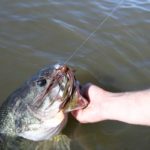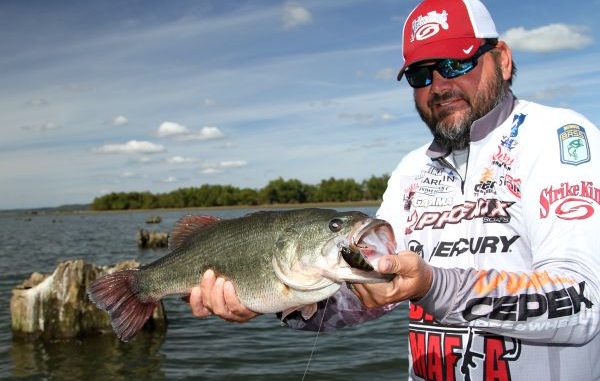
Every angler knows stumps hold bass, but what do you do when you’re faced with a huge field of these snags? These touring pros give you some pointers.
Murder on lower units, but straight-up hog farms — that’s a fitting summary for those shallow, wood-spiked ranges bass anglers call stump fields.
There’s no escaping the very real hazard of shallow-water impacts, but those who take it slow and easy often find stump fields bristling with opportunity.
From large areas of evenly cut stumps, to random scatterings of naturally fallen trees and even your shallow standing timber factors here.
Whatever the form, FLW Tour pro Jay Yelas finds a couple of consistent factors attracting fish to stumps.
“The bass use the stumps and tress to suit their seasonal needs,” Yelas said. “If they’re spawning, they’ll get up next to a stump in 2 to 3 feet of water. The rest of the year, they’re going to be interested in the baitfish.
“Anytime the bait fish are near (wood), the bass use that cover to ambush the bait.”
Bolster those factors with the fact that stumps hold heat for winter comfort and offer shade during sunny times, and the appeal is clear.
Of course, anglers like stumps for their convenient visual reference.
But what’s the best approach to these fields of opportunity?
When sizing up a stump field, start with a visual survey. Look for differences, irregularities — anything that might direct bass into concentrated areas.
Here are some considerations:
• Bigger is better — More mass equals more shade, shelter and ambush potential.
Also, the larger the tree, the larger the root mass, and after years of sediment displacement, big stumps offer lots of pockets into which savvy mama bass can drop their eggs.
“If … you have a lot of different sizes of timber around, the bigger trees are going to be your key targets,” Yelas said. “So you can sort through what’s available and pick out the bigger ones.”
That’s not to say you won’t find quality fish on lesser stumps, so remain alert for any other discernible patterns of positioning, such as tight clusters, distinct pairings and, of course, sun/shadow angles.
• Bottom design — Bass inherently follow natural travel lanes into and out of their seasonal haunts. Drains, ditches, old sloughs — these are the highways and footpaths for largemouth bass.
Remember the fundamental truth that bass first follow bottom contour and then utilize available cover. Referencing lake charts will guide you toward key areas, and then modern forward-viewing sonar can show you the sweet spots.
Yelas said bass favor distinct contour rises offering favorable pre-spawn staging and feeding options. These depth variances funnel baitfish, and bass leverage anything that hastens meals to mouths.
“You might be going down the lake and see a whole forest of trees in (deep) water, but some of them are right on top of a long, flat point in (shallower) water,” Yelas said. “The trees on top of that long, flat point that sticks out into the main lake are the ones you want to target most often.”
But just knowing which stumps are most likely to hold bass doesn’t mean you can put them in the boat. So you have to also understand how to make these wood-oriented fish bite.
Options are many for engaging stump-bound bass, but we can narrow it down to a couple particular categories:
• Reaction baits — Whenever bass are chasing shad or bluegill, a spinnerbait’s significant profile, flash and vibration can prove highly attractive to bass roaming these woody labyrinths.
Short, targeted casts are typically more productive than slow rolling tops burning in this scenario.
Bassmaster Elite Series pro Greg Hackney often uses a Strike King Hack Attack spinnerbait to probe lanes between stumps.
For targeting specific structure, he likes the Strike King KVD 2.5 squarebill, a bait for which the key deal is getting up close and personal. Impacting those wooden remnants makes the squarebill kick outward with sudden, eye-catching surges.
These deflections resemble crawfish scooting from spot to spot or baitfish darting for cover.
In dirtier water, FLW Tour pro Andrew Upshaw finds bigger-bodied baits are easier for bass to locate.
It was this premise that led him to design the Rat-L-Trap Echo — a wide-kicking squarebill with a bulky body that moves a lot of water and calls fish with that traditional Rat-L-Trap sound.
• Flippin’, pitchin’, swimmin’ — Yelas will always have a jig handy for stump-field action because he knows this bait will usually interest the bigger fish.
He’ll go with a 3/8- to a 1-ounce Yamamoto Flippin’ jig tipped with a Yamamoto Flappin’ Hog trailer. Black-and-blue is his top color scheme, and he’ll size his jig based on depth and how much wind the day brings.
Pierre Part pro Cliff Crochet’s also a fan of black/blue jigs, but he keeps a green pumpkin/orange setup handy for spots with clearer water.
His plan includes specific presentations, as well as a broader approach.
“A lot of times you can catch them just swimming a jig,” Crochet said. “As I’m approaching a stump, I’ll swim the jig by it. If she’s there and she wants to eat, she’ll come up and bite it.
“I’ll swim it left side and right side as I’m approaching. Then I’ll flip it right side, front side, left side and back side.
“In March, you want to fish it really slowly — get it in there and hop it.”
And Crochet pointed out that a common stump-fishing hazard can actually work to the angler’s advantage.
Root systems like to grab jigs, but he won’t immediately go into retrieval mode — he’ll leverage the situational dynamics to create a taunting appearance.
“When you flip in there and you feel that you’re on a root, in warm water situations you’d just hop it over and get it going,” Crochet said. “But if I feel that my line is over a root, I’ll use it as a pivot point.
“I’ll pick it up and put it down, and that jig stays in the same spot. That may be a 15-second deal or a 30-second deal, and I’ll do that all the way around the stump.”
For active fish, Crochet backs up his ½-ounce jig with a Luck E Strike Ring Master, a ribbed Beaver-style bait with swimming legs and a big profile.
With hesitant fish, he’ll downsize to a Luck E Strike Drop Dead Craw.
“In March, you’re dealing with (pre-spawn to spawning) fish, and they really get personalities,” Crochet said. “If they’re biting, we can play hard ball. If they’re not, we can play small ball.
“Some of them like to get up and bang in your face, and some of them like to be easy. You just have to see how they like it.”
When the bite’s leaning more to the tough side — maybe the fish have seen too many boats that weekend, or perhaps a weather system has them in a funky mood — Yelas finesses stump fish with a 5-inch unweighted, Texas-rigged Senko on a 5/0 extra wide gap hook.
Green pumpkin is the go-to color, and a simple pitch-and-flutter presentation is hard to beat.
With any presentations, Yelas bases his casting angles on sky conditions.
“Any sort of hard cover is usually better when it’s sunny out because it pulls the fish right in there tight into the shade,” he said. “In these conditions, you have to make a presentation closer.
“But on a cloudy day or early and late in the day, the fish will be near the cover but relating to it more loosely. They’ll come out and chase stuff.”
